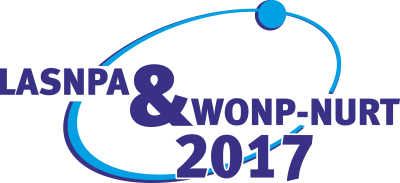Speaker
Description
The purpose of this work was to investigate fission modes in the fission of heavy actinides. The experiments have been carried out at the U400 cyclotron at the FLNR JINR (Dubna, Russia) using the double-arm time-of-flight spectrometer CORSET. To investigate the role of closed proton and neutron shells in fission of $^{248}$Cf, $^{254}$Fm and $^{260}$No nuclei at an excitation energy of 40-45 MeV the mass and energy distributions of fission fragments in the reactions $^{16}$O+$^{232}$Th, $^{16}$O+$^{238}$U, $^{22}$Ne + $^{232}$Th and $^{22}$Ne + $^{238}$U have been measured. For the compound nucleus $^{260}$No$^*$ formed in the reaction $^{22}$Ne + $^{238}$U an increase of fragment yields in the superasymmetric mass region of 52/208 u, that corresponds to the formation of pair of two double magic nuclei $^{48}$Ca and $^{208}$Pb, were observed. Moreover, for $^{260}$No$^*$ compound nucleus at the initial excitation energy of 41 MeV the bimodal fission was observed. In this case at the symmetric mass split the both fission fragments was close to the double magic $^{132}$Sn. For the compound nuclei $^{248}$Cf and $^{254}$Fm* formed in the reactions $^{16}$O+$^{232}$Th, $^{16}$O+$^{238}$U and $^{22}$Ne + $^{232}$Th an increase of fragment yields in the mass region 70/180 u that corresponds to the nuclei $^{70}$Ni was observed. It present an interesting case because the initial excitation energy of compound nuclei was around 40-45 MeV whereas typically shell structure starts to break at around 20-30 MeV.
